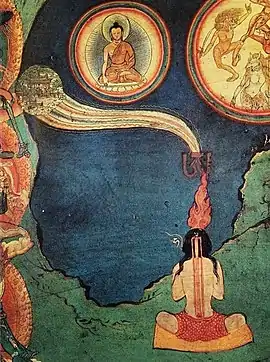Tummo
Tummo (Tibetan: གཏུམ་མོ, Wylie: gtum-mo ; Sanskrit: चण्डाली, romanized: caṇḍālī) is the fierce goddess of heat and passion in Tibetan Buddhist tradition.[1] Tummo is found in the Mahasiddha Krishnacarya and the Hevajra Tantra texts.[2]
| Part of a series on |
| Tibetan Buddhism |
|---|
 |
As a breathing exercise, tummo (Tumo or Chandali yoga) is a part of tantric meditation cycles for yogic heat, developed around the concept of the female deity.[1][3][4] It is found in the Six Dharmas of Naropa, Lamdre, Kalachakra and Anuyoga teachings of Tibetan Vajrayana. The purpose of tummo is to gain control over body processes during the completion stage of 'highest yoga tantra' (Anuttarayoga Tantra) or Anuyoga.
Nomenclature, orthography and etymology
Tummo (gTum mo in Wylie transliteration, also spelled Tumo, or Tum-mo; Sanskrit caṇḍālī or Chandali) is a Tibetan word, literally meaning fierce [woman]. Tummo is a Tibetan word for inner fire.[5]
Tummo may also be rendered in English approximating its phonemic enunciation as 'Dumo'.[6]
Practice
The "center channel" (dbu ma or avadhuti) is the whole arterial system, or more specifically the aorta.[7] The two "side channels" are the venous system (roma or rasanā) and the spinal column and nervous system (rkyang ma or lalanā).[8] A chakra is any place in the body where there are clusters of arteries, veins and nerves.
In the practice of tummo, the visualization of lower ends to the three channels is primarily used to focus body awareness in the subnavel area.[9] Breath retention, mulabandha and uddiyana bandha force vāyu (wind, air) and ojas into the arterial system.[9] Ojas itself has two stores within the body—the heart and brain.[9] Thus there is the visualization of blazing and dripping.[9]
Kundalini and tummo
Miranda Shaw clarifies:
Kuṇḍalinī-yoga offered a range of techniques to harness the powerful psycho-physical energy coursing through the body... Most people simply allow the energy to churn in a cauldron of chaotic thoughts and emotions or dissipate the energy in a superficial pursuit of pleasure, but a yogi or yogini consciously accumulates and then directs it for specified purposes. This energy generates warmth as it accumulates and becomes an inner fire or inner heat (candālī) that [potentially] burns away the dross of ignorance and ego-clinging.[10]
Numerous non-buddhist tantras of the Shakta and Shaiva traditions (generally termed Hindu by westerners) speak of Kundalini, which is generally described as a coiled energy at the base of the spine,[11][12][13] at the first chakra.
Overview

Kurt Keutzer (2002) discusses the Kundalini yoga, Vajrayana, Nath Sampradaya, Mahasiddha and Milarepa:
Kundalini yoga in the Natha Sampradaya and Vajrayana in Tibetan Buddhism both take their origin from the Mahasiddhas who were active in India from the 8th century to the 12th century. Kundalini yoga practices formed the core of the teachings of a number of these Mahasiddhas and are strongly represented in both Tibetan Buddhist practices and contemporary kundalini yoga practices. Kundalini yoga was spoken of as "Candali yoga" by these Mahasiddhas and became known as gTummo rnal 'byor in Tibet. Candali yoga was a key practice of the famous Tibetan yogin Milarepa.[14]
Modern western witnesses of this practice include the adventurer Alexandra David-Néel (David-Néel, 1971), Lama Anagarika Govinda (Govinda, 1988), and anthropologist Dr. John Crook. Dr Arya (2006) in discussing the winds (Tibetan: rLung) states that historically: "The rLung practitioner (yogi) uses special colors of clothes to improve the power of the Tummo fire."[15]
Dr Arya (2006) also states:
The psychic heat Drod is produced by the space particles and the heat manifested from the friction of the wind element. This is another fundamental element as it supports and gives power to the consciousness, like the power of the fire that can launch rockets to space. The power is called medrod or 'digestion fire' in medicine and Tummo in yoga tantra. The heat (fire) sustains life and protects the body/mind. The psychic fire increases the wisdom, burns the ignorant mind of the brain and gives realization and liberation from the darkness of unawareness. That is why yoga describes Tummo as the aggressive fire which ignites from below navel, pierces the chakras one by one and reaches the sky of the crown chakra. The tummo burning arrow married with the celestial bride leads to enjoy the life of transformation of samsara. They give birth to the son of awareness from the blissful garden of Vajrayogini.[15]
Scientific investigation
Studies on Tibetan monks and Western control group have demonstrated the effect of increased thermal power output using the forceful breath technique that depends in part on meditative visualization.[16] A 1982 study of the physiological effects of Tummo has been made by Benson and colleagues, who studied Indo-Tibetan Yogis in the Himalayas and in India in the 1980s. Conducted in Upper Dharamsala in India, it found that the subjects, three monks, exhibited the capacity to increase the temperature of their fingers and toes by as much as 8.3 °C (14.9 °F).[17] In a 2002 experiment reported by the Harvard Gazette, conducted in Normandy, France, two monks from the Buddhist tradition wore sensors that recorded changes in heat production and metabolism.[18] A 2013 study by Kozhevnikov and colleagues showed increases in core body temperature in both expert meditators from eastern Tibet and Western non-meditators. The expert meditators using Tummo visualisation and exercises were able to increase body temperature the most.[16]
Notes
- John Crook; James Low (1997). The Yogins of Ladakh: A Pilgrimage Among the Hermits of the Buddhist Himalayas. Motilal Banarsidass. pp. 89–90. ISBN 978-81-208-1479-0.
- Migmar Tseten (2008). Treasures of the Sakya Lineage: Teachings from the Masters. Shambhala Publications. pp. 252–254. ISBN 978-0-8348-2309-9.
- Ra Yeshe Senge (2015). The All-Pervading Melodious Drumbeat: The Life of Ra Lotsawa. Penguin. pp. 242 see entry for Tummo. ISBN 978-0-698-19216-4.
- Dharmakirti (2002). Mahayana tantra: an introduction. Penguin Books. pp. 126–127.
- Yeshe, Lama Thubten (1998). The Bliss of Inner Fire: Heart Practice of the Six Yogas of Naropa. Boston: Wisdom Publications. p. 22. ISBN 978-0-86171-136-9.
- Chang, G.C.C. (1993). Tibetan Yoga. New Jersey: Carol Publishing Group. ISBN 0-8065-1453-1, p.7
- Gyatso, Janet (2004). "The Authority of Empiricism and the Empiricism of Authority: Medicine and Buddhism in Tibet on the Eve of Modernity". Comparative Studies of South Asia, Africa and the Middle East. 24 (2).
- Gyatso, Janet (2004). "The Authority of Empiricism and the Empiricism of Authority: Medicine and Buddhism in Tibet on the Eve of Modernity". Comparative Studies of South Asia, Africa and the Middle East. 24 (2).
- Lama Yeshe. The Bliss of Inner Fire. Wisdom Publications. 1998, pg.135-141.
- Shaw, Miranda (1995). Passionate Enlightenment::Women in Tantric Buddhism. Princeton University Press. p. 31. ISBN 978-0-691-01090-8.
- Flood, Gavin. An Introduction to Hinduism. (Cambridge University Press: Cambridge, 1996). ISBN 0-521-43878-0, p. 99.
- Harper, Katherine Anne; Brown, Robert L. (2002). The Roots of Tantra. Albany, New York: State University of New York Press. ISBN 978-0-7914-5306-3., p. 94
- McDaniel, June (2004). Offering Flowers, Feeding Skulls Popular Goddess Worship in West Bengal. Oxford University Press. p. 103. ISBN 978-0-19-516790-0.
- Keutzer, Kurt. kundalini-faq Kundalini: Frequently Asked Questions and Selected References. Retrieved 2007-12-27.
- Arya, Pasang Yonten (2009). Tibetan Tantric Yoga. Source: (accessed: January 8, 2012)
- Kozhevnikov, M; Elliott, J; Shephard, J; Gramann, K (2013). "Neurocognitive and Somatic Components of Temperature Increases during Tummo Meditation: Legend and Reality". PLOS ONE. 8 (3): e58244. Bibcode:2013PLoSO...858244K. doi:10.1371/journal.pone.0058244. PMC 3612090. PMID 23555572.
- Benson, Herbert (1982). "Body temperature changes during the practice of g Tum-mo yoga". Nature. 295 (5846): 234–235. doi:10.1038/295234a0. PMID 7035966.
- Cromie, William (18 April 2002). "Meditation dramatically changes body temperatures". The Harvard Gazette. Retrieved 23 February 2019.
References
- David-Neel, Alexandra (1971) Magic and Mystery in Tibet. Dover Publications
- Ding-E Young, John and Taylor, Eugene (1998) Meditation as a Voluntary Hypometabolic State of Biological Estivation . News in Physiological Sciences, Vol. 13, No. 3, 149-153, June 1998
- Evans-Wentz, W. Y. Editor (2000) Tibet's Great Yogi Milarepa: A Biography from the Tibetan being the Jetsün-Kabbum or Biographical History of Jetsün-Milarepa, According to the Late Lama Kazi Dawa-Samdup's English Rendering. USA:Oxford University Press
- Govinda, Lama Anagarika (1988) Way Of White Clouds. Shambhala Publications
- Mullin, Glen H. (2006) The Practice of the Six Yogas of Naropa, Snow Lion Publications.
- Mullin, Glen H. (2005) The Six Yogas of Naropa: Tsongkhapa's Commentary, Snow Lion Publications.
- Turner, Robert P.; Lukoff, David; Barnhouse, Ruth Tiffany; Lu, Francis G. (1995). "Religious or Spiritual Problem. A Culturally Sensitive Diagnostic Category in the DSM-IV". Journal of Nervous and Mental Disease. 183 (7): 435–444. doi:10.1097/00005053-199507000-00003. PMID 7623015.
- Yeshe, Lama Thubten (1995) The Bliss of Inner Fire: Heart Practice of the Six Yogas of Naropa, Wisdom Publications.
